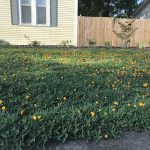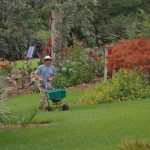Turf lawns provide an excellent groundcover that hold soil in place, filter pollutants, and are beautiful. However, turfgrass may not be your first groundcover choice, due to heavy shade, landscape layout, or just personal preference. In that case, there are a lot of alternative groundcovers on the market. To help determine what groundcovers do best under certain conditions and to provide information on lawncare and groundcover maintenance, this month’s Gardening in the Panhandle LIVE! was all about groundcovers.

‘Needlepoint’ Perennial Peanut in a yard. Photo Credit: Daniel Leonard, University of Florida/IFAS Extension – Calhoun County
Turfgrass/Groundcover Selection
The University of Florida/IFAS has a long list of publications on alternatives to turfgrass. The comprehensive list can be found at Ask IFAS: Groundcovers.
One of the groundcovers that does well in full sun and has beautiful yellow flowers is perennial peanut. More information on perennial peanut can be found in the publication “Guide to Using Rhizomal Perennial Peanut in the Urban Landscape”.
Groundcover options for the shade include Algerian ivy, Asiatic jasmine, and mondo grass. Read more about these and other shade friendly species at “Gardening Solutions: Groundcovers for the Shade”.
Frogfruit can tolerate full sun and partial shade.
You could also create a wildflower meadow in a sunny spot. More wildflower information is available at Ask IFAS: Performance of Native Florida Plants Under North Florida Conditions.
White clover is a groundcover that may be best suited in a mix with other groundcover species. The publication “White Clover” provides some excellent information on growing this plant.
A number of factors come into play when you are choosing a turfgrass species. Some species are more tolerant of shade than others and maintenance levels are species and variety specific. The “Choosing Grass for Your Lawn” webpages can help answer some common questions. For additional information on turfgrass species a list of EDIS publications and other UF/IFAS websites is available at Ask IFAS: Your Florida Lawn. (Note: Buffalograss is not recommended for Florida.)
Overseeding is not a recommended practice for home lawns, but information is available at the webpage “Overseed Florida Lawns for Winter Color”.
Management of Turf and Groundcovers
Turfgrass requires the right amount of care. To help maintain a good looking yard, follow the management practices in the publication “Homeowner Best Management Practices for the Home Lawn”.
A soil sample is a good place to start to determine the root of the issues you may have in your lawn. Follow these simple steps to collect and submit a sample for accurate analysis.
Weed management can be difficult in turf and other groundcovers. Cultural, mechanical, and chemical controls can help keep weeds under control. The “Weed Management Guide for Florida Lawns” provides control options for the majority of weeds you’ll encounter in your lawn. More information on weed control in turf alternatives can be found in the publication “Improving Weed Control in Landscape Beds”.
Virginia buttonweed is a common weed that is often difficult to control. Doveweed can also be difficult to control.
The publication “Adopting a Florida Friendly Landscape” outlines the nine principals to help you design, install, and maintain a landscape that will thrive in our climate.
Fertilizer is required to maintain a healthy lawn. A list of lawn fertilization publications and links can be found at Ask IFAS: Lawn Fertilizer.
Lawns in the southeast are susceptible to a number of different diseases mostly thanks to our hot and humid weather. But there are some preventative and curative practices you can implement to help keep disease under control. The “Turfgrass Disease Management” publication answers a lot of questions about disease control.
Past episodes of Gardening in the Panhandle LIVE can be found on our YouTube playlist.
- Gardening in the Panhandle LIVE! Program Summary: Pests of Florida Lawns and Landscape Plants - May 28, 2025
- Fun Facts About Ferns - April 30, 2025
- Gardening in the Panhandle LIVE! Program Summary: Freeze Friendly Foliage Plants - April 30, 2025

